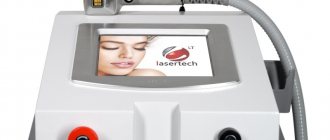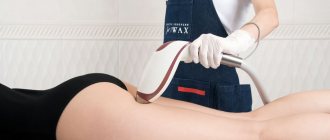Laser hair removal is a popular cosmetic procedure for removing body hair. After it, the skin becomes smooth, silky and pleasant to the touch. However, hair removal results do not always live up to expectations. Skin defects may occur that are very difficult to get rid of. Therefore, before carrying out the procedure, you should definitely familiarize yourself with the potential risks.
Contraindications for hair removal
Laser hair removal is accompanied by exposure of the skin surface to light rays. The principle of operation of the device is as follows: a stream of light reaches the bulb and blood vessels, promoting their heating and subsequent death. Therefore, the follicles are destroyed and hair growth stops in the treated area.
A repeated laser hair removal procedure, which is carried out after 25-30 days, removes the remaining hairs that were previously in a state of sleep. After 10 sessions of such manipulation, the follicles become completely incapacitated.
All light devices are accompanied by instructions for use, which detail diseases that are a contraindication to the procedure.
Laser hair removal is prohibited in the following cases:
- Neoplasms of any origin.
- Low immunity associated with severe pathologies.
- Allergies are in the acute stage.
- Any skin diseases, especially infectious ones.
- Diabetes mellitus.
- Varicose veins and spider veins.
It is also worth holding off on this procedure if the client has at least one of the following conditions:
- The period of bearing a child and breastfeeding.
- Hormonal imbalance.
- Infection with viruses and various infections.
- Inflammatory processes on the skin in the area of intended hair removal.
- Flu, cold.
- Damage to the skin - wounds, cuts, scratches.
What happens after the procedure?
Firstly, you should not expect instant results. The hair in the area where the session was performed will fall out along with the roots, but not immediately. Only a small area is treated in one manipulation. Further, depending on the location of hair removal, another 4-10 sessions will be required. In exceptional cases more, it all depends on the structure of the hair, follicles and hormones in our body. It is recommended to repeat the manipulations until the hair completely disappears and its growth stops, the desired interval is 1-2 months. But you will be pleased with the effect.
It is important to follow certain rules after laser hair removal. Is it harmful to health to visit a solarium after the procedure? Yes, it is harmful, just like tanning in the natural sun. Avoid active sunbathing for at least two weeks. And if you are lucky enough to be in the sun, be sure to use protective equipment: help your body adapt to the results as painlessly as possible. Avoid visiting the bathhouse and swimming pool, regularly use moisturizing and softening nourishing milk or cream. It is desirable that their composition be natural so as not to provoke an allergic reaction. Harsh peelings and cosmetic procedures should also not be carried out, as well as trying to pluck remaining hairs with tweezers or remove them with wax. Believe me, the next session will remove them completely along with the roots.
Many people look for information about laser hair removal in reviews from doctors. “Is this dangerous?” we ask once again. No, it is not dangerous if all recommendations are followed. If you are afraid of burns during the procedure, you may be given a cooling agent. Some cosmetic clinics have even introduced special cold laser hair removal, when the skin does not heat up. By the way, increasing body temperature when exposed to a conventional laser can provide additional benefits: blood circulation improves, and the process of natural collagen synthesis under the skin is activated, which helps us look younger.
If you don’t have enough information about laser hair removal and whether it is harmful to health, reviews of those who have already appreciated the effect of this wonderful technology can be found on the Internet. You will discover what changes await you:
- velvety smooth skin
- long-lasting effect
- if the procedure is carried out correctly, there is no long-term inflammatory processes
- no ingrown hairs or unpleasant irritation
We hope that our article has helped you learn more about what laser hair removal is, what contraindications and deep effects this procedure may have.
Consequences of laser hair removal
Even in the absence of contraindications, no one is immune from the development of side effects. As a rule, they arise as a result of:
- Poor preparation of the skin for light exposure.
- The specialist made a mistake in diagnosing the patient.
- Presence of one of the contraindications. Many people may not fully know their illnesses.
- The functions of the device are incorrectly configured, prolonged exposure to a certain area of the skin.
- Individual intolerance to laser manipulation.
The main consequences after hair removal using light equipment are:
- Burns.
- Black dots.
- Pimples.
- Itching and irritation.
- Pigmentation.
- Folliculitis.
- Bruises.
Is epilation of armpits and bikini area harmful?
When answering the question whether a deep bikini is harmful or not, it is worth remembering the non-invasive, non-contact and sterile nature of the method.
Its implementation does not harm the external and internal genital organs of a woman. Confirmation of this is the active use of lasers for vulvovaginal rejuvenation, which eliminates age-related atrophy, muscle relaxation, stress urinary incontinence and prolapse (protrusion) of the genitals. Laser hair removal also does not cause any harm to the armpits. Author: Khazova Alla Sergeevna
Itching and irritation
Slight skin tightness, burning and discomfort are normal immediately after the procedure. Therefore, at the end of the session, the cosmetologist applies soothing agents to the skin. However, the persistence of unpleasant sensations in the form of itching and irritation for more than 2-3 days after hair removal indicates intolerance to the procedure. In such a situation, it is important to carefully care for your skin; you should exclude aggressive cosmetics and use only emollients. Decoctions of medicinal plants are useful - chamomile, calendula, sage, aloe vera. They soothe the epidermis, relieve inflammation and itching.
How is the procedure performed?
Before laser treatment of the face, the patient must wear protective glasses over his eyes to prevent damage to the cornea and retina. In the area where the treatment will take place, the hair is trimmed a few millimeters above the surface of the skin (this can be done at home with a razor in advance). A cold gel or special cooling agent is used to protect the outer layers. With its help, laser light penetrates the epidermis more easily. The device sets parameters that take into account the patient's skin tone, color, thickness, hair location and the amount of energy required for the procedure to be effective.
The laser emits pulses of energy that travel through the hair follicle. It absorbs this energy and is destroyed. The laser targets the pigment that gives skin, eyes and hair their color – melanin. It protects against the sun's dangerous rays by absorbing harmful UV rays before they penetrate deeper into the body.
The laser contains single wavelengths, creating a very narrow beam of light that can be focused onto a tiny area. The result is a very concentrated and powerful form of energy. When the melanin in the hair absorbs the rays, it heats up to 100 degrees Celsius. As the water evaporates, it burns and creates an explosion with a plume of smoke. Is it harmful to the skin? Although it seems counterintuitive to bombard your body with intense radiation, laser hair removal is safe as long as it is performed correctly.
Do not take a “laser bath” of the whole body in one procedure. The goal of hair removal is to ultimately stop hair growth. To achieve this, the procedure must not cause damage. Typically six pulses are delivered at a time, each lasting 1.5 milliseconds. The process of working laser beams on your hair produces a brief flash of pain, like someone snapping a rubber band on your skin. It is necessary to consider all the pros and cons before making a decision.
Myth 3: Laser photoepilation is more effective than traditional procedures
A new hair removal technique, positioned as laser photoepilation, is nothing more than misinformation to the population. There is no such method of dealing with excess vegetation. Laser and photoepilation are two completely different techniques. The only similarity between cosmetic procedures is the principle of action: the splitting of the follicle occurs due to selective heating of the hair follicles and absorption of light energy. In one case, a laser acts on the follicles, and in the other, light.
Underestimation of risk: complications with contraindications
You can enjoy smooth, velvety skin and forget about the razor for several years only if you pay close attention to contraindications. The desire to use the services of a cosmetologist at any cost can lead to an exacerbation of existing chronic diseases. If there are contraindications, skin defects may appear - discoloration, age spots, scars.
With diabetes, a person may feel relatively comfortable, but this is not a reason to neglect the recommendations. Pathological processes occur unnoticed in the body - the sensitivity of nerves increases, metabolism and tissue regeneration slow down, and immunity decreases. In diabetics, a small wound can cause gangrene of the limb, and treating a large area of skin with an energy beam will lead to more serious consequences.
Complications with contraindications can be serious with any cosmetic procedure. Before carrying out the procedure, be sure to consult with a cosmetologist and, if necessary, with specialized specialists.
Laser treatment of hair follicles
Imagine the method of starting a fire using a magnifying glass, where sunlight directed at one point heats and then ignites flammable material. The laser operates on the same principle. In our case, sunlight is a laser beam, and the “combustible material” is the melanin pigment, which is responsible for coloring hair. The beam penetrates the hair follicle, heats it up and promotes hair destruction.
The laser interacts only with mature hair follicles that have accumulated sufficient color pigment to become a suitable target. It is the “ripe” hair follicles that attract the beam and are best susceptible to destruction.
Important point for beginners! Pigmentation is, first of all, color saturation. The laser affects the so-called dark cells. The “hair fossae,” which are considered dark, are filled with a subtype of melanin called eumelanin. It is this type of pigment that is responsible for a wide range of natural hair colors - from light brown to black.
Is laser hair removal harmful for albinos, “straw blondes” and gray people whose hair cells do not have eumelanin? No, the procedure will not cause harm, but there will be no benefit from it, because the follicles of the listed types of people do not have light-absorbing abilities. On the contrary, the hair follicles of natural-born blondes put up a shield for the laser beam, preventing its penetration.
When the laser beam is absorbed by the hair follicles, a thermal reaction occurs: the hair shaft heats up and the cells of the so-called hair papilla are destroyed. As a result, hair stops growing for quite a long time - on average, we can talk about stopping growth for 5-7 years. In the future, when individual hair sprouts appear in some places of the treated area, they will no longer be dark and hard. They will be replaced by lighter and softer fluff.
Classic bikini
Laser hair removal of a classic bikini is considered quite popular. It involves removing hair along the extreme line of underwear. Approximately the removal occurs on 2 cm of the thigh and 3 cm on the inside of the pubis. The average procedure time is 20 minutes.
Deep bikini
This type involves removing hair from the pubic area, outside the labia and on the inside of the thigh. The laser also affects the buttocks area. A deep bikini takes at least 40 minutes. Since the procedure is accompanied by discomfort, the use of local painkillers is necessary.
Total bikini
Total hair removal involves complete removal of vegetation in the intimate area. The hair on the inside of the labia is also laser-treated. Duration is at least an hour. Since the manipulation is painful, anesthesia is needed.











